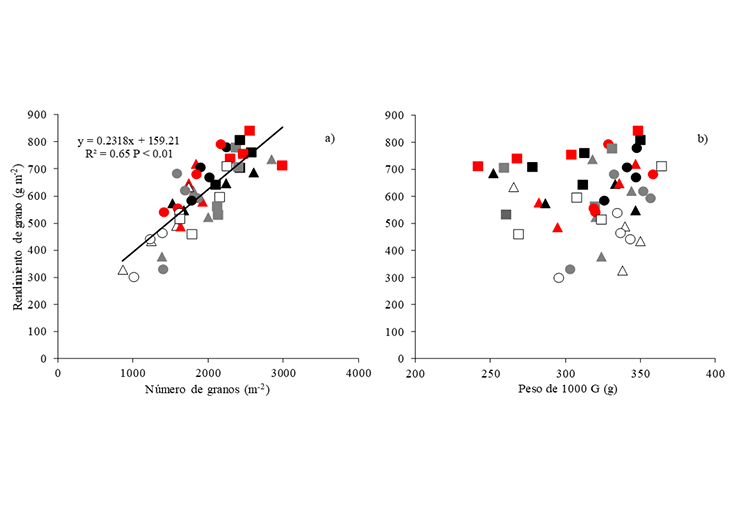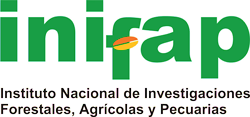Morphological and physiological components determining yield in native and hybrid corn (Zea mays L.) cultivars in response to density and sowing date.
DOI:
https://doi.org/10.29312/remexca.v16i4.3708Keywords:
Zea mays L, population density, sowing dateAbstract
Grain yield in corn is a function of genotype, agronomic management and environmental conditions where it is grown. The objective of this investigation was to study the impact of planting date and stocking density on grain yield and its components in four maize genotypes for Valles Altos de México. The experiment was carried out in the Toluca Valley, Mexico, during the spring-summer cycle of 2022. Two trilineal cross hybrids: Faisán® and Cherokee® and two native cultivars: "Criollo Blanco and Amarillo Zanahoria", were evaluated under four population densities of 50,000, 60,000, 70,000 and 80,000 plants per ha-1 on three planting dates in March, April and May. On each planting date, the treatments resulting from the possible combinations of genotypes and planting densities were established under a randomized complete block design with four replications. The results showed that the May planting obtained an average grain yield of 6.7 t ha-1. The late planting date increased biomass, harvest index, number of grains per m2, number of grains per ear, plant height and consequently grain yield per m2. Of the 4 genotypes evaluated, the Faisán hybrid had the highest grain yield explained by a greater number of grains per m2. The increase in population density increased grain yield with 80,000 plants ha-1 explained by a higher number of ears per m2. In 2022 the March and April plantings were affected by high temperature and low precipitation, while corn planted in May was not limited by precipitation. The date x cultivar x density interaction revealed the highest grain yield, 8.3 t ha-1, in the May planting with the "Criollo Blanco" cultivar and a density of 80,000 plants ha-1.
Downloads
References
Andrade, F. H.; Cirilo, A. G. and Uhart, S. U. 2023. Ecofisiología y manejo del cultivo de maíz. MAIZAR, Asociación Maíz y Sorgo Argentino. 311-327. pp.
Andrade, F. H.; Vega, C. R.; Uhart, S. U.; Cirilo, A.; Cantarero, M. and Valentinuz, O. 1999. Kernel number determination in maize. Crop Science. 39(2):453-459.
ASGROW. 2022. Catálogo de productos. https://www.asgrow.com.mx/es-mx/productos/maiz/product-detail-template.html/faisan-valles-altos-altos.html.
ASPROS. 2022. Catálogo productos de Valles Altos. https://asprossemillas.com/wp-content/uploads/2022/04/Valles-Altos-2022.pdf. 1-2 pp.
Desloires, J. D.; Ienco, D. A. and Botrel, A. A. 2023. Out of year corn yield prediction at field-scale using Sentinel-2 satellite imagery and machine learning methods. Comput. Electron. Agric. 209(1):1-14. 10.1016/j.compag.2023.107807.
Djaman, K. K.; Allen, S.C.; Djaman, S. D.; Koudahe, K. K.; Irmak, S. S.; Puppala, N. N.; Darapuneni, K. M. and Angadi, V. S 2022. Planting date and plant density effects on maize growth, yield and water use efficiency. Environ. Chall. 6(1):1-11. Doi.org/10.1016/j.envc.2021.100417.
Espinosa, C. A.; Tadeo, R. M.; Turrent, F. A.; Sierra, M. M.; Gómez, M. N. y Zamudio, G. B. 2013. Rendimiento de variedades precoces de maíz grano amarillo para Valles Altos de México. Agronomía Mesoamericana. 24(1):93-99.
FAOSTAT. 2022. Organización de las Naciones Unidas para la Agricultura y la Alimentación. Base de datos estadísticos. http://www.fao.org.
Feng, L.; Raza, M. A.; Chen, Y.; Khalid, M. H. B.; Meraj, T. A.; Ahsan, F. and Yang, W. 2019. Narrow-wide row planting pattern improves the light environment and seed yields of intercrop species in relay intercropping system. PloS one. 14(2):e0212885.
Fernández, J. A.; Messina, C. D.; Salinas, A. M.; Prasad, P. V.; Nippert, J. B.; Ciampitti, I. A. 2022. Kernel weight contribution to yield genetic gain of maize: a global review and US case studies. J. Exp. Bot. 73(11):3597-3609. https://doi.org/10.1093/jxb/erac103.
Ferraris, G. N.; Lopez, M. B.; Barberis, S. S.; Mancuso, S. E. and Cuirolo, J. L. 2020. Estudio de la interacción entre cultivar, densidad y fertilización nitrogenada según fecha de siembra maíz-Campaña 2019/20. EEA Pergamino, INTA. 1-15 pp.
García, D. M. E. 1988. Modificaciones al sistema de clasificación climática de Köppen. Instituto Nacional de Geografía-Universidad Nacional Autónoma de México (UNAM). México. 246 p.
García, M. H.; Flores, M. H.; Khalil, G. A.; Ascencio, H. R.; Tijerina, C. L.; Vázquez, P. M. A. and Mancilla, V. O. R. 2020. Estimación de la fracción de cobertura de la vegetación en maíz (Zea mays) mediante imágenes digitales tomadas por un vehículo aéreo no tripulado (UAV). Revista Fitotecnia Mexicana. 43(4):399-399.
González, H. A.; Sahagún, C. J.; Vázquez, L. M.; Rodríguez, J. E.; Pérez, D. J.; Domínguez, L. A.; Franco, M. O. y Balbuena, M. A. 2009. Identificación de variedades de maíz sobresalientes considerando el modelo AMMI y los índices de Eskridge. Agricultura Técnica en México. 35(2):189-200.
Hütsch, B. W. and Schubert, E. S. 2017. Harvest Index of Maize (Zea mays L.): are there possibilities for improvement? Advances in Agronomy. 37-82. Doi:10.1016/bs.agron.2017.07.004.
Jiang, W.; Thapa, S.; Jessup, K.; Hao, B.; Hou, X.; Marek, T. and Xue, Q. 2020. Corn response to later than traditional planting dates in the Texas High Plains. Crop Science. Doi:10.1002/csc2.20042.
Liu, W.; Hou, P.; Liu, G.; Yang, Y.; Guo, X. and Ming, B. 2020. Contribution of total dry matter and harvest index to maize grain yield a multisource data analysis. Food and Energy Security. 9(4):1-12. Doi.org/10.1002/fes3.256.
Maddonni, G. A.; Angel, P. M. and Rotili, D. H. 2021. Manejo de la estructura del cultivo de maíz en ambientes marginales de la Argentina; Universidad de Buenos Aires. Facultad de Agronomía. Agronomía y Ambiente. 412(11):90-105.
Maltense, N. E.; Michelin, C. I. and Melchiori, R. J. M. 2022. Densidad y mecanismos de plasticidad para el maíz en escenarios climáticos inciertos. Serie Extensión INTA Paraná Núm. 89. 68-75 pp.
Martínez, G. A.; Zamudio, G. B.; Tadeo, R. M.; Espinosa, C. A.; Cardoso, G. J. C.; Vázquez, C. G. y Turrent, F. A. 2018. Rendimiento de híbridos de maíz grano blanco en cinco localidades de Valles Altos de México. Revista Mexicana de Ciencias Agrícolas. 9(7):1447-1458. Doi.org/10.29312/remexca.v9i7.1357.
Massigoge, I. M.; Ross, F. R.; Fernández, J. A.; Echarte, L. L.; Ciampitti, I. A. and Cerrudo, A. A. 2022. Contribution of tillers to maize yield stability at low plant density. Crop Science. 62(6):2451-2461. Doi.org/10.1002/csc2.20827.
Otegui, M. E. and y Mercau, J. L. 2021. Fecha de siembra y rendimiento de maíz 1 en ambientes con provisión hídrica contrastante de la región central de Argentina. Anales de la ANAV, tomo LXXI. 150-160 pp. http://sedici.unlp.edu.ar/handle/10915/127399.
Quiroz, M. J.; Pérez, L. D. J.; González, H. A.; Rubí, A. M.; Gutiérrez, R. F.; Franco, M. J. R. P. and Ramírez, D. J. F. 2017. Respuesta de 10 cultivares de maíz a la densidad de población en tres localidades del centro mexiquense. Revista Mexicana de Ciencias Agrícolas. 8(7):1521-1535.
Raza, M. A.; Bin-Khalid, M. H.; Zhang, X.; Feng, L. Y.; Khan, I.; Hassan, M. J. and Yang, W. 2019. Effect of planting patterns on yield, nutrient accumulation and distribution in maize and soybean under relay intercropping systems. Scientific reports. 9(1):4947.
Ruiz, A. A.; Trifunovic, S. T.; Eudy, D. M.; Sciarresi, C. S.; Baum, M. B.; Danalatos, G. J. N.; Elli, E. F.; Kalogeropoulos, G. K.; King, K. X.; Santos, C. D.; Thies, A. A.; Pico, L. O.; Castellano, M. J.; Schnable, P. S.; Topp, C. C.; Graham, M. X.; Lamkey, K. R.; Vyn, T. J. and Archontoulis, S. V. 2023. Harvest index has increased over the last 50 years of maize breeding. Field Crops Research. 300(5):1-10. Doi.org/10.1016/j.fcr.2023.108991.
Tadeo, R. M.; Zamudio, G. B.; Espinosa, C. A.; Turrent, F. A.; Cárdenas, M. A. L.; López, L. C.; Arteaga, E. I. and Valdivia, B. R. 2015. Rendimiento de maíces nativos e híbridos en diferente fecha de siembra y sus unidades calor. Revista Mexicana de Ciencias Agrícolas. 6(1):33-43.

Published
How to Cite
Issue
Section
License
Copyright (c) 2025 Revista Mexicana de Ciencias Agrícolas

This work is licensed under a Creative Commons Attribution-NonCommercial 4.0 International License.
The authors who publish in Revista Mexicana de Ciencias Agrícolas accept the following conditions:
In accordance with copyright laws, Revista Mexicana de Ciencias Agrícolas recognizes and respects the authors’ moral right and ownership of property rights which will be transferred to the journal for dissemination in open access. Invariably, all the authors have to sign a letter of transfer of property rights and of originality of the article to Instituto Nacional de Investigaciones Forestales, Agrícolas y Pecuarias (INIFAP) [National Institute of Forestry, Agricultural and Livestock Research]. The author(s) must pay a fee for the reception of articles before proceeding to editorial review.
All the texts published by Revista Mexicana de Ciencias Agrícolas —with no exception— are distributed under a Creative Commons License Attribution-NonCommercial 4.0 International (CC BY-NC 4.0), which allows third parties to use the publication as long as the work’s authorship and its first publication in this journal are mentioned.
The author(s) can enter into independent and additional contractual agreements for the nonexclusive distribution of the version of the article published in Revista Mexicana de Ciencias Agrícolas (for example include it into an institutional repository or publish it in a book) as long as it is clearly and explicitly indicated that the work was published for the first time in Revista Mexicana de Ciencias Agrícolas.
For all the above, the authors shall send the Letter-transfer of Property Rights for the first publication duly filled in and signed by the author(s). This form must be sent as a PDF file to: revista_atm@yahoo.com.mx; cienciasagricola@inifap.gob.mx; remexca2017@gmail.
This work is licensed under a Creative Commons Attribution-Noncommercial 4.0 International license.


